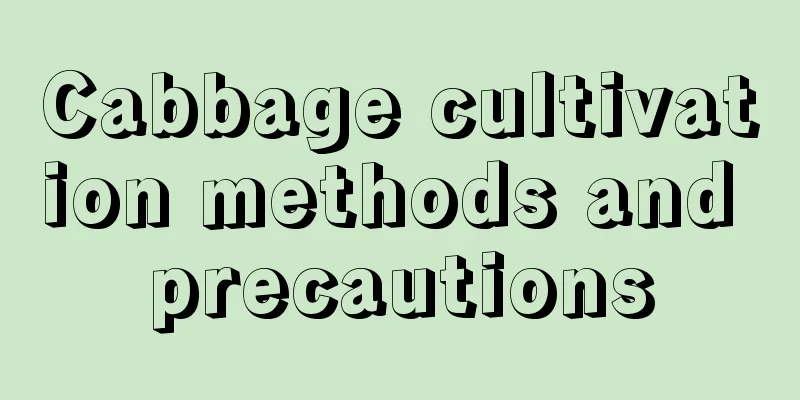Cabbage cultivation methods and precautions

1. Maintenance methods1. Soil: Growing cabbage has very high requirements on soil fertility and requires the soil to have a high humidity. It is suitable to be planted in fertile soil with good drainage. 2. Light: Cabbage prefers light and is suitable to be planted in places with good light. Insufficient light will seriously affect the yield of cabbage, but certain protective measures should be taken in summer to avoid burning the leaves. 3. Temperature: Cabbage prefers a mild climate, and the seeds are most suitable for germination at eight to ten degrees. It is best to control the temperature between 10 and 22 degrees during the growing period. When it exceeds 30 degrees, it will not be suitable for its growth. When the temperature is below 5 degrees, frost damage is likely to occur. 4. Water: Cabbage should be watered more frequently. The soil needs to be kept moist during the growing period. It is best to have no water accumulation on the surface, but there should be no water shortage. Sufficient water is an important factor in ensuring high yield. 2. Breeding techniques1. Sowing: Direct seeding is generally adopted, with row seeding as the main method and on-demand seeding as the auxiliary method. Before sowing, you need to select plump seeds. Some varieties have a low germination rate, so you must choose carefully. After selecting the seeds, they should be sown in time and the soil should be kept moist after sowing. 2. Summer: Summer is the main season for cabbage growth. The temperature should be controlled below 30 degrees, because if the temperature is too high, it will stop growing and its yield will be affected to a certain extent. 3. Problem diagnosis and treatment1. Disease: Cabbage is prone to soft rot, which usually occurs during the heart stage and causes rot. When it appears, it must be removed in time, and then sprayed with medicine for timely treatment. In addition, water should be irrigated reasonably to ensure sufficient moisture. 2. Pests: Spodoptera litura is a common pest that will eat the surface of the plant. In severe cases, it will eat up all the leaves. It should be treated in time. Insects should be eliminated as much as possible in the early stages of an infestation to avoid problems later. IV. Other issues1. Is it poisonous? Cabbage is a common vegetable and is edible. You can consider planting some in the open space at home. It is also easy to manage. 2. Can it be planted in the ground: Cabbage is generally planted around July and August, mainly in open space. Attention should be paid to regular fertilization and irrigation, and attention should also be paid to preventing the occurrence of diseases. |
<<: Cultivation methods and precautions of Zisun ball
>>: Cultivation methods and precautions of Da Cangjiaodian
Recommend
How long does it take for hyacinth to grow roots and bloom in hydroponics?
1. How long does it take for hyacinth to grow roo...
Do pomegranates need to be watered every day?
Do you water pomegranates every day? Pomegranate ...
Introduction to Luanshu, how much does Luanshu cost
1. Family Koelreuteria paniculata is a plant of t...
When will the peony seedlings bloom? How to raise peony seedlings?
1. How long does it take to bloom? After peony is...
The flower language and plant culture of tomato
Flower Language The flower language of tomato is ...
Can lisianthus be planted in the ground?
Can lisianthus be planted in the ground? Lisianth...
The value of Alpinia glabra
The medicinal value of Alpinia glabra The rhizome...
How to take cuttings of jasmine flowers and when to take cuttings
1. How to propagate the jasmine flower by cutting...
How to grow roses to make them flourish
Tips for caring for roses soil When growing roses...
How to grow pearl bush
1. Watering Usually, good drainage is required wh...
Technology of grafting pitaya onto Schlumbergera
1. Grafting time There is no limit to the graftin...
Does Fraxinus chinensis grow fast? How thick can it grow in a year?
Growing environment of Fraxinus chinensis Fraxinu...
Is it profitable to grow apple trees? How much profit can you make from growing apple trees?
Is growing apple trees profitable? Apple trees en...
When is the best time to plant broad beans?
Broad bean , also known as broad bean, orchid bea...
What does white chrysanthemum mean?
1. Mourning and remembering White chrysanthemum i...









